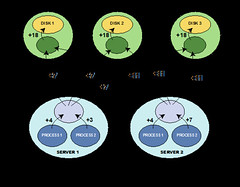 It remains that, from the same principles, I now demonstrate the frame of the System of the World. -- Isaac Newton
It remains that, from the same principles, I now demonstrate the frame of the System of the World. -- Isaac Newton
The practice of IT reminds me a lot of the practice of science before Isaac Newton. Aristotelianism was dead, but there was nothing to replace it. Then Newton came along, created a scientific revolution with his System of the World. And everything changed. That was New System of the World number one.
New System of the World number two was written about by the incomparable Neal Stephenson in his incredible Baroque Cycle series. It explores the singular creation of a new way of organizing society grounded in new modes of thought in business, religion, politics, and science. Our modern world emerged Enlightened as it could from this roiling cauldron of forces.
In IT we may have had a Leonardo da Vinci or even a Galileo, but we’ve never had our Newton. Maybe we don't need a towering genius to make everything clear? For years startups, like the frenetically inventive age of the 17th and 18th centuries, have been creating a New System of the World for IT from a mix of ideas that many thought crazy at first, but have turned out to be the founding principles underlying our modern world of IT.
If you haven’t guessed it yet, I’m going to make the case that the New System of the World for IT is that much over hyped word: cloud. I hope to show, using many real examples from real startups, that the cloud is built on a powerful system of ideas and technologies that make it a superior model for delivering IT.
IT has had an explosion of creativity: open source, deep and powerful tool chains, lean and agile development, cloud computing, virtualization, BigData, parallel programming, distributed monitoring, distributed programming, NoSQL, cost driven programming, dynamic languages, real-time processing, asynchronous programming, distributed teams, mobile platforms, viral loops, flat networks, software defined networking, wimpy cores, DevOps, everything as a service, infrastructure as code, and so on and so on. Astounding innovation wherever you look.
We are just now figuring out what new structures and systems are replacing the old, but if you step back a bit, what seems to be happening is we are creating a new “frame” using a bottom up methodology that just may be a new System of the World for IT. What is merging is a new way of working synthesised from all the diverse forces catalogued above. We’ve created a sort of new physics of development in place of a collection of prescientific alchemical lore.
Since it is startups tackling problems that can’t be solved using traditional methods, it is through them that we’ll explore this new System of the World or IT.
It’s Not All About the Cloud, but It’s Mostly About the Cloud
Click to read more ...
 Thursday, May 10, 2012 at 9:15AM
Thursday, May 10, 2012 at 9:15AM 
















 It remains that, from the same principles, I now demonstrate the frame of the System of the World. -- Isaac Newton
It remains that, from the same principles, I now demonstrate the frame of the System of the World. -- Isaac Newton



